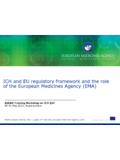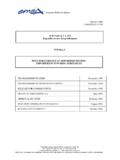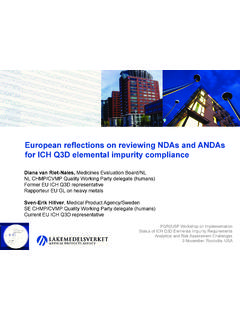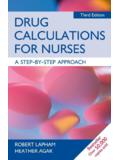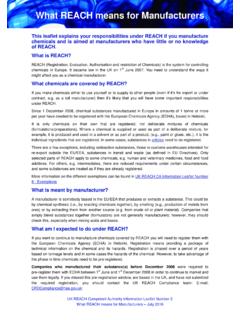Transcription of ANTIBACTERIAL AGENTS IN CLINICAL …
1 1 ANTIBACTERIAL AGENTS IN CLINICAL DEVELOPMENTAn analysis of the ANTIBACTERIAL CLINICAL development pipeline, including tuberculosisWHO/EMP/ World Health Organization 2017 Some rights reserved. This work is available under the Creative Commons Attribution-NonCommercial-ShareAlike IGO licence (CC BY-NC-SA IGO; ). Under the terms of this licence, you may copy, redistribute and adapt the work for non-commercial purposes, provided the work is appropriately cited, as indicated below. In any use of this work, there should be no suggestion that WHO endorses any specific organization, products or services. The use of the WHO logo is not permitted.
2 If you adapt the work, then you must license your work under the same or equivalent Creative Commons licence. If you create a translation of this work, you should add the following disclaimer along with the suggested citation: This translation was not created by the World Health Organization (WHO). WHO is not responsible for the content or accuracy of this translation. The original English edition shall be the binding and authentic edition . Any mediation relating to disputes arising under the licence shall be conducted in accordance with the mediation rules of the World Intellectual Property citation. ANTIBACTERIAL AGENTS in CLINICAL development: an analysis of the ANTIBACTERIAL CLINICAL development pipeline, including tuberculosis.
3 Geneva: World Health Organization; 2017 (WHO/EMP/ ). Licence: CC BY-NC-SA (CIP) data. CIP data are available at , rights and licensing. To purchase WHO publications, see To submit requests for commercial use and queries on rights and licensing, see Third-party materials. If you wish to reuse material from this work that is attributed to a third party, such as tables, figures or images, it is your responsibility to determine whether permission is needed for that reuse and to obtain permission from the copyright holder. The risk of claims resulting from infringement of any third-party-owned component in the work rests solely with the disclaimers.
4 The designations employed and the presentation of the material in this publication do not imply the expression of any opinion whatsoever on the part of WHO concerning the legal status of any country, territory, city or area or of its authorities, or concerning the delimitation of its frontiers or boundaries. Dotted and dashed lines on maps represent approximate border lines for which there may not yet be full mention of specific companies or of certain manufacturers products does not imply that they are endorsed or recommended by WHO in preference to others of a similar nature that are not mentioned.
5 Errors and omissions excepted, the names of proprietary products are distinguished by initial capital reasonable precautions have been taken by WHO to verify the information contained in this publication. However, the published material is being distributed without warranty of any kind, either expressed or implied. The responsibility for the interpretation and use of the material lies with the reader. In no event shall WHO be liable for damages arising from its use. Design and layout:Printed in Geneva, SwitzerlandContentsAcknowledgementsAbbre viations and acronymsExecutive summary1. Introduction2. Methods and search Scope and inclusion Assessment of activity against priority pathogens and innovativeness3.
6 AGENTS in CLINICAL Antibiotics potentially active against pathogens on the WHO priority pathogens Combinations without new chemical AGENTS in development for treating AGENTS in development for treating Clostridium difficile Biological AGENTS that are not under active development or for which there is no recent information4. Analysis of the CLINICAL pipeline5. Outlook and The current CLINICAL pipeline is insufficient against pathogens on the WHO priority pathogens list and More innovative approaches are required, but there are scientific Outlook: More work is required to fill the Methodological considerations6.
7 ReferencesAnnex 1. Search strategy and resultsAnnex 2. Declarations of interests of advisory group members456101212121414 2324252729 293131 32 33333642444 AcknowledgementsThis publication was prepared by the WHO Department of Essential Medicines and Health Products (EMP) under the leadership of Peter Beyer (WHO/EMP). Ursula Theuretzbacher (Centre for Anti-infective AGENTS , Austria) was the leading scientific expert. She prepared the documentation for the advisory group and drafted the final report with the support of Simon Gottwalt (WHO/EMP), who was also responsible for planning the project, collecting data and preparing the advisory group meeting.
8 We thank the members of the advisory group, which met in Geneva, Switzerland, on 12 13 June 2017 to review the data, discuss and assess the compounds referred to and provide feedback on the report. The advisory group consisted of: Dr Mark Butler, Senior Researcher, Institute for Molecular Bioscience, University of Queensland, Brisbane, Australia Dr Lloyd Czaplewski, Director, Chemical Biology Ventures, Abingdon, United Kingdom of Great Britain and Northern Ireland Professor Stephan Harbarth, Associate Professor, Division of Infectious Diseases and Infection Control Programme, Geneva University Hospitals, WHO Collaborating Centre, Geneva, Switzerland (Chair)
9 Dr Jean-Pierre Paccaud, Director, Business Development and Corporate Strategy, Drugs for Neglected Diseases initiative, Geneva, Switzerland Professor Mical Paul, Director, Infectious Diseases Institute, Rambam Health Care Campus, and Associate Professor, The Ruth and Rappaport Faculty of Medicine, Technion Israel Institute of Technology, Haifa, Israel Dr John H. Rex, Chief Strategy Officer, CARB-X, Boston, United States of America (USA), and Chief Medical Officer, F2G Ltd, Manchester, United Kingdom Dr Lynn Silver, Owner, LL Silver Consulting, Springfield, NJ, USA Dr Melvin Spigelman, President and Chief Executive Officer, Global Alliance for TB Drug Development, New York City, NY, USA (technical resource person) Dr Ursula Theuretzbacher, Centre for Anti-infective AGENTS , Vienna, Austria.
10 Professor Guy Thwaites, Director, Oxford University CLINICAL Research Unit, Ho Chi Minh City, Viet Nam, and Professor of Infectious Diseases, University of Oxford, Oxford, United KingdomWe would like to thank Nicole Homb (WHO/EMP) for her contribution to managing conflicts of interest and the development of the methodology; Christian Lienhardt (WHO/ Global TB Programme) for contributions on the tuberculosis research and development pipeline; and Nicola Magrini (WHO/EMP), Lorenzo Moja (WHO/EMP) and Sarah Paulin (WHO/EMP) for their contributions to development of the method and for reviewing and finalizing the report.










